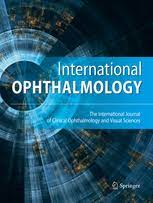Keratoconus after 40 years of age: a longitudinal comparative population-based study
Authors
Affiliations
1Noor Ophthalmology Research Center, Noor Eye Hospital, Tehran, Iran.
2ASCEND Center for Biomedical Research, Morgan State University, Baltimore, MD, USA.
3Ophthalmic Epidemiology Research Center, Shahroud University of Medical Sciences, Shahroud, Iran.
4Department of Epidemiology and Biostatistics, School of Public Health, Tehran University of Medical Sciences, PO Box: 14155-6446, Tehran, Iran. afotouhi@tums.ac.ir.
Abstract
Purpose: To determine 5-year changes in keratoconus indices and corrected distance visual acuity in 40-64-year-old keratoconus compared with normal subjects.
Methods: In this prospective population-based cohort study, 5-year changes in Belin grading system indices including the average radii of curvature in the 3 mm zone surrounding the thinnest point in the anterior (ARC-3 mm) and posterior (PRC-3 mm) cornea, corrected distance visual acuity, minimum corneal thickness, maximum Ambrosio’s relational thickness (ART-max), and maximum anterior keratometry indices centered on steepest point in the central 3 mm (Kmax-3 mm), 4 mm (Kmax-4 mm), and 5 mm (Kmax-5 mm) zones were compared between keratoconus and normal participants. In the analysis, comparisons were made between all keratoconus eyes and the right eyes of normal participants.
Results: The mean age in the keratoconus (n = 16 eyes) and normal (n = 1986 eyes) groups (48.31 ± 4.78, 49.37 ± 5.79 years, respectively) was not statistically different (P = 0.327). The two groups differed in terms of changes in PRC-3 mm (- 0.07 ± 0.15 vs. + 0.001 ± 0.14 mm, respectively, P = 0.042) and ART-max (- 6.28 ± 25.19 vs. + 15.8 ± 72.7 μm, respectively, P = 0.003). There were significant correlations between the reduction in PRC-3 mm and its baseline value (β = – 0.20, P < 0.001) and keratoconus (β = - 0.26, P < 0.001). The reduction in ART-max significantly correlated with its baseline value (β = - 0.43, P < 0.001) and keratoconus (β = - 111.74, P < 0.001). Conclusion: According to these findings, posterior corneal steepening and thinning in keratoconus patients continue after the age of 40 years, but it is clinically negligible. The changes are independent of normal age-related changes and appear to be slower in cases with steeper and thinner corneas.
Keywords: Corneal thinning; Ectasia display indices; Keratoconus; Middle age; Posterior corneal steepening.

